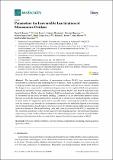Parameters for irreversible inactivation of monoamine oxidase
Abstract
The irreversible inhibitors of monoamine oxidases (MAO) slow neurotransmitter metabolism in depression and neurodegenerative diseases. After oxidation by MAO, hydrazines, cyclopropylamines and propargylamines form a covalent adduct with the flavin cofactor. To assist the design of new compounds to combat neurodegeneration, we have updated the kinetic parameters defining the interaction of these established drugs with human MAO-A and MAO-B and analyzed the required features. The Ki values for binding to MAO-A and molecular models show that selectivity is determined by the initial reversible binding. Common to all the irreversible inhibitor classes, the non-covalent 3D-chemical interactions depend on a H-bond donor and hydrophobic-aromatic features within 5.7 angstroms apart and an ionizable amine. Increasing hydrophobic interactions with the aromatic cage through aryl halogenation is important for stabilizing ligands in the binding site for transformation. Good and poor inactivators were investigated using visible spectroscopy and molecular dynamics. The initial binding, close and correctly oriented to the FAD, is important for the oxidation, specifically at the carbon adjacent to the propargyl group. The molecular dynamics study also provides evidence that retention of the allenyl imine product oriented towards FADH− influences the formation of the covalent adduct essential for effective inactivation of MAO.
Citation
Ramsay , R R , Basile , L , Maniquet , A , Hagenow , S , Pappalardo , M , Saija , M C , Bryant , S , Albreht , A & Guccione , S 2020 , ' Parameters for irreversible inactivation of monoamine oxidase ' , Molecules , vol. 25 , no. 24 , 5908 . https://doi.org/10.3390/molecules25245908
Publication
Molecules
Status
Peer reviewed
ISSN
1420-3049Type
Journal article
Description
Funding:RRR, AA, SH and SB are grateful to COST Action CA13153 for facilitating their collaboration and funding short-term visits. AA acknowledges funding under P1-0005 (Slovenian Research Agency). The APC was funded by MDPI.Collections
Items in the St Andrews Research Repository are protected by copyright, with all rights reserved, unless otherwise indicated.

